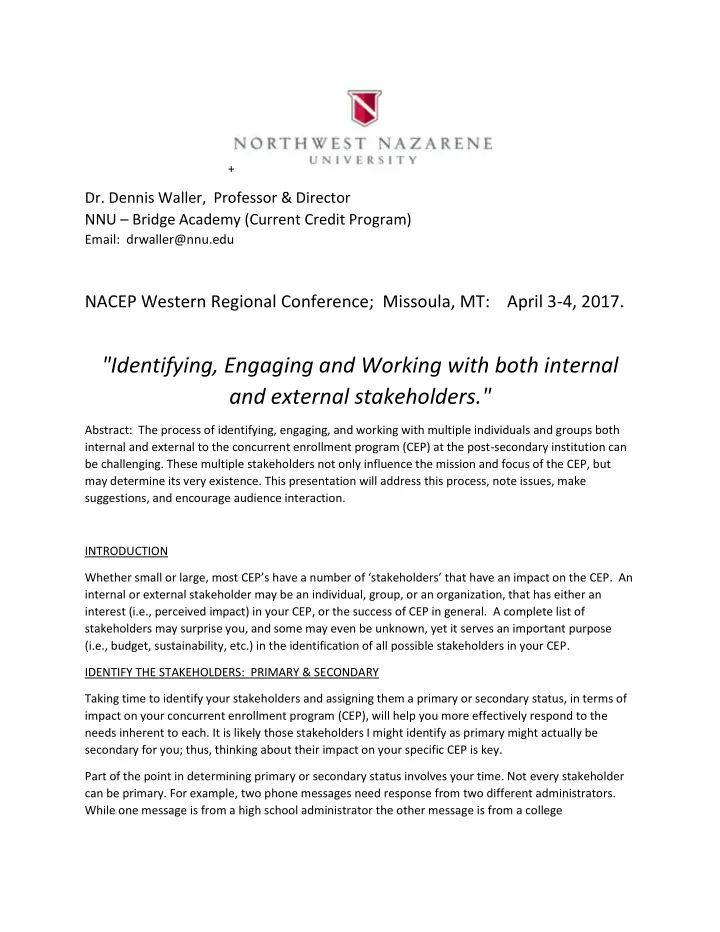

+ Dr. Dennis Waller, Professor & Director NNU – Bridge Academy (Current Credit Program) Email: drwaller@nnu.edu NACEP Western Regional Conference; Missoula, MT: April 3-4, 2017. "Identifying, Engaging and Working with both internal and external stakeholders." Abstract: The process of identifying, engaging, and working with multiple individuals and groups both internal and external to the concurrent enrollment program (CEP) at the post-secondary institution can be challenging. These multiple stakeholders not only influence the mission and focus of the CEP, but may determine its very existence. This presentation will address this process, note issues, make suggestions, and encourage audience interaction. INTRODUCTION Whether small or large, most C EP’s have a number of ‘stakeholders’ that have an impact on the CEP. An internal or external stakeholder may be an individual, group, or an organization, that has either an interest (i.e., perceived impact) in your CEP, or the success of CEP in general. A complete list of stakeholders may surprise you, and some may even be unknown, yet it serves an important purpose (i.e., budget, sustainability, etc.) in the identification of all possible stakeholders in your CEP. IDENTIFY THE STAKEHOLDERS: PRIMARY & SECONDARY Taking time to identify your stakeholders and assigning them a primary or secondary status, in terms of impact on your concurrent enrollment program (CEP), will help you more effectively respond to the needs inherent to each. It is likely those stakeholders I might identify as primary might actually be secondary for you; thus, thinking about their impact on your specific CEP is key. Part of the point in determining primary or secondary status involves your time. Not every stakeholder can be primary. For example, two phone messages need response from two different administrators. While one message is from a high school administrator the other message is from a college
administrator. Although both messages are important, I have previously placed primary status on communication with high school administrators and would respond to that message first. COMMON STAKEHOLDERS 1. High school students and their parents. Although separate stakeholders, students and parents are tightly linked, as both have similar course-specific concerns. We can say all we want about poor communication between these two groups, but I generally find that when it comes to educational issues involving the concurrent enrollment program and the future of their education, both students and parents tend to be fairly united in seeking the same information. Two primary issues: a. Cost. Concurrent enrollment programs take a wide variety of approaches to addressing the cost of courses to students, including tuition and/or fees. Involvement in NACEP and discussions with program staff from other colleges across the country opened my eyes to the range of approaches. Depending upon the state, school, or school district, the specific CEP course cost may range from nothing to a minimal tuition fee (usually a fraction of the tuition paid at the college for the same course). Scholarships may be available to defray even a minimal tuition or fee; however, they are usually based upon a temporary federal or state grant or offered through a local/regional foundation or service club, and so should not be confused with the normal scholarship processes of the college. Should a CEP charge a minimal tuition fee, the collection of payment requires its own set of policies and procedures that may raise questions from students or parents unfamiliar with tuition or educational fees. b. Benefits. The benefits of concurrent enrollment program (CEP) courses may seem logical to those of us in colleges that offer these programs. However, the logic is often lost on students and parents who have never attended college. They may not understand the academic concepts of credit acceptance, transferability, moving ahead on general education or elective courses, tuition discounts, or future tuition savings. Thus, explanation becomes very important to these students and parents. Helping the student and parent understand how paying for concurrent enrollment program credit for a course now can mean later savings upon entering college can be difficult. Basically, each course offered through a concurrent enrollment program and transferable for general education or elective equivalency can save the student hundreds of dollars in tuition. For example, one story I love to tell involves a parent who called me one September and reported that his daughter had all of her concurrent enrollment program credits accepted at an out-of-state private college, which gave her sophomore standing and saved him more than $20,000 in tuition. Similar stories recur every year. 2. Teachers in the high school seem to be most concerned about the students and opportunities offered to them by taking a concurrent enrollment program (CEP) course. Thus, course rigor is important only because it is ultimately important to the student in receiving credit for the course. Benefits for involvement as a CEP faculty member tend to be of limited personal interest, except for direct benefits received through professional development opportunities that may result in educational credit, which may in turn help move teachers up the school district salary scale. The use of monetary compensation paid to the CEP faculty member for participation is mixed across the United States, but when allowed it does provide an additional incentive for faculty participation. The option of offering monetary compensation can be limited by state, district, or teacher union policies. In addition, it may increase the competition between different colleges, as some qualified faculty may "shop around" and even offer their services to the highest bidder. The offering of teacher benefits is not a simple issue and should be
Recommend
More recommend